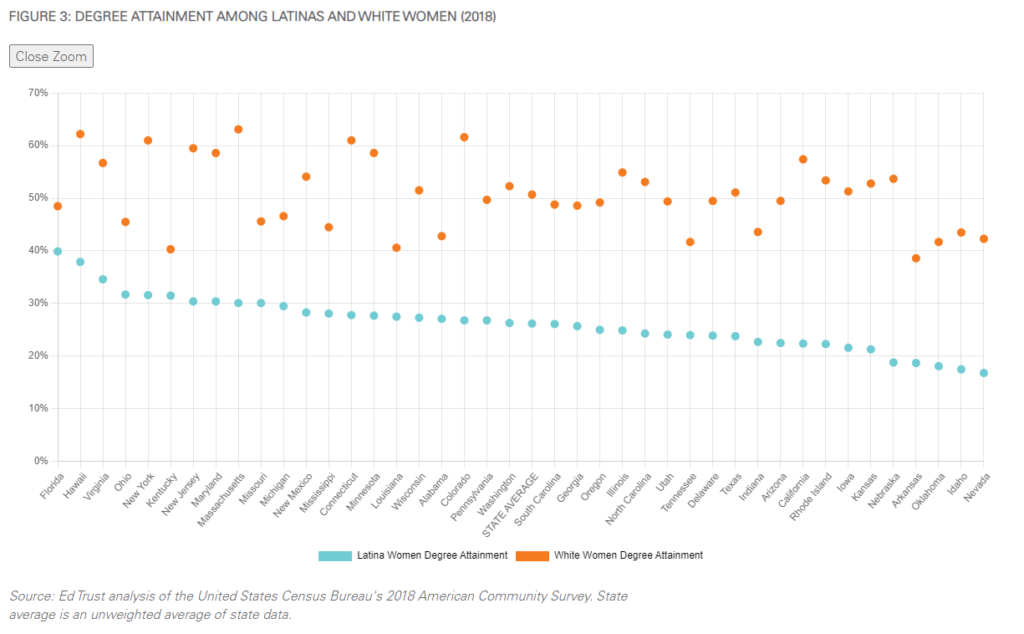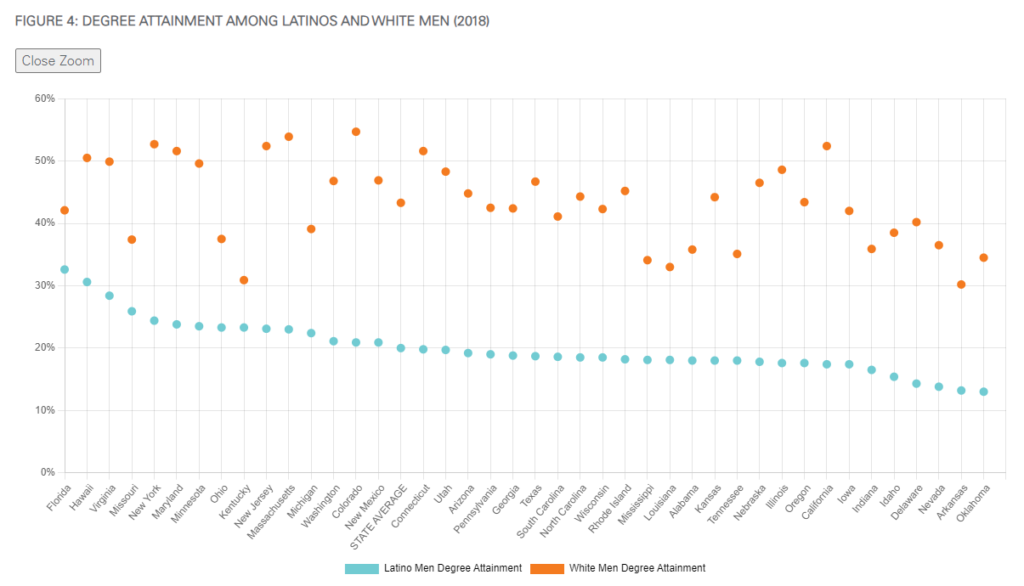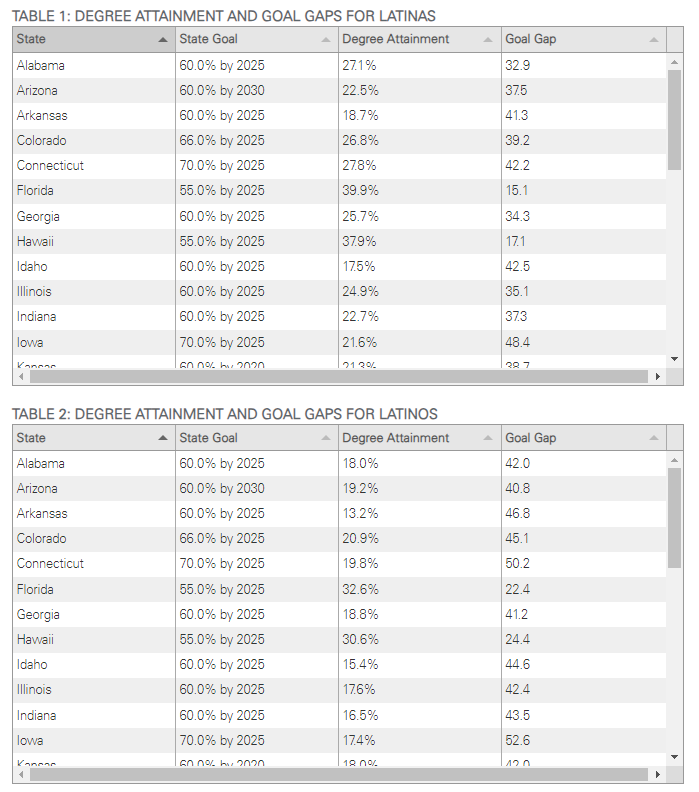
COVID-19 and its economic and educational fallout have had a disproportionate impact on communities of color and have highlighted and exacerbated longstanding racial and ethnic inequities in the U.S. The impact on college-going among Hispanic[1] students has been especially concerning. Before COVID-19, college enrollment among Hispanic students was on the rise (with Latinas, in particular, making major strides and outpacing Latinos when it comes to earning college degrees).
But that was then. According to recent data from the National Student Clearinghouse, Hispanic enrollment in higher education fell by 5.4 percentage points last fall amid the pandemic. When we look at differences by sector and level, those declines become even more dismaying. While enrollment at public four-year colleges fell nearly two percentage points, enrollment at community colleges fell 10.6 percentage points overall and nearly 17 percentage points among Latinos, versus a decline of 6.2 percentage points for Latinas. These declines are particularly troubling, since over 52% of Hispanic higher-education students attend community colleges. The decline in first-time enrollment among Hispanic students — which sank nearly 20 percentage points across all sectors — should also ring alarm bells, since this group is one of the largest and fastest-growing segments of the U.S. population, and college attendance is strongly associated with better health, employment, and economic outcomes. If we don’t take concerted steps to counter these declines, opportunity gaps in this country will only grow, and Hispanics will be left behind.
Hispanic adults have long had lower attainment than White adults (and, as a result, they have often been trapped in low-wage jobs that don’t require a college degree). In our previous work, we found a 24.5-percentage point gap in degree attainment between Hispanic adults and White adults. And while that gap is due, in no small part, to the impact of immigration and income inequality, the role of organized schooling on the educational attainment of Latinos and Latinas cannot be ignored. Hispanic students have less access to high-quality pre-K and attend schools that are more poorly funded; they also have less access to experienced teachers, a full range of math and science courses, school counselors and gifted/talented and advanced placement and international baccalaureate programs. Needless to say, schools in this country are failing many Hispanic students. As Supreme Court Justice Sonia Sotomayor has noted, “until we get equality in education, we won’t have an equal society.” Unfortunately, the U.S. was a long way from education equity before the pandemic, and COVID-19 is only widening disparities. Unless we address these longstanding structural inequities, we will continue to see vastly divergent outcomes along racial, ethnic, and gender lines — and that’s something our increasingly diverse country can ill afford.
Educational Attainment Among U.S. Latinas and Latinos
In this brief, we examine gender differences in educational attainment between Latino and Latina adults before COVID-19, and highlight national and state trends in degree attainment by race and gender. While disparities exist between Latina and Latino adults, both groups are less likely than their White counterparts to have a college degree (Figure 1). Just over a quarter of Latinas hold a college degree compared to slightly more than half of White women and slightly less than half of White men, while only 1 in 5 Hispanic adults have a college degree (i.e., an associate degree or higher).
While educational attainment among Hispanics has grown over the last two decades, Hispanic adults are less likely to hold a college degree, and they are overrepresented among adults who have a high school diploma or less: Slightly more than half of Latinas and over 60.0% of Latinos have only a high school diploma or less versus roughly 28% of White women and 35% of White men. This may be partially explained by the differing educational attainment levels among some recent Latin American immigrants, which vary by country of origin (some groups arrive in the U.S. with lower levels of education than the typical American), but family finances and lower postsecondary enrollment rates (which are closely linked) are also key factors. Hispanic students are still underrepresented at both two- and four-year institutions when compared to their demographics and their White counterparts.
There are also considerable ethnic and gender gaps in the types of degrees earned (Figure 2). White women and men are more likely to hold bachelor’s and graduate degrees than their Hispanic peers. Bachelor’s degree attainment for both White women and men is over 20 percentage points higher than it is for Latinas and Latinos (Figure 2). The percentage of White women with a bachelor’s degree (25.1%) is almost higher than the percentage of Latinas with any type of college degree (26.6%); it’s also higher than the percentage of college-educated Latinos (20.7%). While there is evidence of the value of associate degrees, bachelor’s and graduate-level degrees tend to provide greater job security and higher wages. If we are going to have greater societal equality, we must improve access, completion and attainment for Latinas and Latinos.
State Degree Attainment Trends
In this section, we examine state-level data on degree attainment for Latinas and Latinos in 41 states. We excluded states with fewer than 15,000 Hispanics, since degree attainment estimates for these small samples are less reliable. First, we examine state-level attainment for Latinas and attainment gaps between them and White women. Next, we provide the same analysis for Latinos. Finally, we look at the attainment differences between Latinas and Latinos in each state. State-level data on degree attainment for Latinas and Latinos is included in Tables A and B in the Appendix.
2018 Degree Attainment Among Latinas
In the states we examined, slightly more than a quarter (26.2%) of Latinas have a college degree, on average. In 10 states (Florida, Hawaii, Virginia, Ohio, New York, Kentucky, New Jersey, Maryland, Massachusetts, and Missouri), Latinas have attainment rates exceeding 30.0% (Figure 3). However, in five states (Nebraska, Arkansas, Oklahoma, Idaho, and Nevada), attainment rates among Latinas are below 20.0%. While California has the largest gap between Latinas and White women, eight states — including California, Nebraska, Colorado, Connecticut, Massachusetts, Kansas, Rhode Island, and Minnesota — have gaps of more than 30 percentage points. Only four states (Ohio, Louisiana, Kentucky, and Florida) have attainment gaps of less than 15 percentage points; however, the smaller gaps in Louisiana and Kentucky are largely the result of low attainment among White women compared to other states. In every single state, Latinas have lower levels of degree attainment than White women.

2018 Degree Attainment Among Latinos
Like Latinas, Latinos have lower levels of degree attainment than White men in every state we examined. On average, 1 in 5 (20.0%) Latinos hold a college degree in these 41 states (Figure 4). Florida and Hawaii are the only states in which Latinos have attainment rates higher than 30.0%. In four states (Florida, Hawaii, Virginia, and Missouri), more than a quarter of Latinos hold a college degree. In nearly two-thirds of the states we examined, fewer than 1 in 5 Latinos are college educated. California has the largest gap in attainment between Latinos and White men. And, in 70% (29 of 41) of the states we examined, the attainment gaps exceed 20 percentage points. Only two states (Florida and Kentucky) have attainment gaps of less than 10 percentage points. The small gap in Kentucky is largely a product of extremely low attainment among White men in the state.

Attainment Gaps Between Latinas and Latinos
In every single state we examined, Latinas have higher levels of degree attainment than Latinos (Figure 5). The average gap in attainment between Latinas and Latinos is 6.2 percentage points. At 10 percentage points, Mississippi has the largest attainment gap. In nearly half of the states we examined, the attainment gap between Latinas and Latinos is 7 percentage points or higher. In less than a quarter of states (10 of 41), the gap is relatively small — below 5 percentage points. While Nebraska has a 1 percentage point gap, attainment among Latinas and Latinos in that state is extremely low compared to other states.
Gaps in State Attainment Goals and Degree Attainment Among Hispanic Adults
While many states have been pushing to increase attainment rates in an effort to meet expanding labor needs, we see clear indications that their attempts are falling short. In this section, we compare state degree attainment goals to the attainment rates for Hispanic adults. Thirty-five of the 41 states in our analysis have statewide degree attainment goals. But lagging attainment rates among Latinas and Latinos in each and every state indicates that states will have trouble meeting those goals (Table 1). Per our analysis, these states have double-digit goal gaps — i.e., the difference between the statewide goal and actual degree attainment — of more than 15 percentage points for Latinas and 22 percentage points for Latinos. In Oregon and Oklahoma, the goal gap among Latinas is more than 50 percentage points. Meanwhile, one-third of the states with a statewide attainment goal have a goal gap of over 40 percentage points. In most states (33 of 35), Latina attainment is off target by more than 20 percentage points.
The picture for Latinos is even more alarming. Oregon and Oklahoma also have the widest goal gaps among Latinos, but the goal gap among Latinos exceeds 50 percentage points in Oregon, Oklahoma, Iowa, Rhode Island, and Connecticut. In 27 of the 35 states with attainment goals, there’s a goal gap of over 40 percentage points. And in every single state, Latino attainment is missing state goals by more than 20 percentage points.

Conclusion
Hispanics are one of the largest and fastest-growing demographic groups in the country and, over the last two decades, more of them have been going to college. Since 2000, the enrollment rate among Hispanics has grown by double digits, the highest of any other major racial and ethnic group. Unfortunately, the impact of COVID-19 — which has had a particularly devastating toll on people of color — threatens to reverse this trend and widen educational and economic inequality in this country. Our previous work noted that fewer than a quarter of Hispanic adults actually have a college degree. In fact, Hispanic adults have the lowest college attainment level of the country’s major racial and ethnic groups, and the current crisis threatens to expand gaps and erase much of the progress they’ve made.
That is where federal investment comes in. The U.S. government should increase investments in TRIO programs, which help first-generation students, students with disabilities, and students from low-income backgrounds move through the academic pipeline and have been shown to improve access for students of color. Federal investment in evidenced-based student success initiatives, like CUNY ASAP, could also help close completion gaps for students of color. And doubling the Pell Grant would have a significant impact on Hispanic student enrollment, since nearly 50% of them receive Pell Grants.
States, meanwhile, should track attainment by race and gender against their statewide attainment goals and establish interim metrics and targets for improvement. And investing in need-based scholarship programs that expand pathways to and through college for students of color would go a long way toward boosting access and degree completion. Lastly, since a high percentage of students of color start out at community colleges, states should improve transfer and articulation to smooth the transition between two- and four-year colleges.
At the institutional level, colleges should adjust their recruitment strategies and visit schools that enroll higher numbers of students of color. It’s also imperative that colleges recruit and retain more faculty of color, as this has been shown to improve student success; colleges should also invest in need-based, rather than merit-based, scholarships, and improve campus climate, so students of color feel welcome on college campuses.
The stakes are high. As the U.S. becomes increasingly diverse, addressing the structural inequities that make earning a college degree disproportionately more difficult for students of color and prioritizing their educational success is more than just a matter of social and economic justice; it’s smart policy and good for the country.
About the Data
For this brief, we used data from the United States Census Bureau’s American Community Survey (ACS) to examine degree attainment at the national and state levels. Degree attainment is defined as the percentage of adults between the ages of 25 and 64 who have a postsecondary degree (i.e., an associate, bachelor’s, or graduate degree). For the national degree attainment estimates in Figures 1 and 2, we used 2018 ACS data. This data includes adults in all states and Washington, D.C.
We calculated the degree attainment estimates for states using three-year averages of ACS data from 2016, 2017, and 2018. We used a three-year average to mitigate the influence of sampling errors and single-year anomalies for states with small populations. To avoid potential sampling errors, we excluded states from the analysis that had an average estimated population of Latinas or Latinos below 15,000 in 2016-2018. We included attainment data for 41 states. We excluded Alaska, Maine, Montana, New Hampshire, North Dakota, South Dakota, Vermont, West Virginia, and Wyoming.
About the Authors
A former higher education research analyst at The Education Trust, Marshall Anthony Jr., Ph.D., is now a senior policy analyst at the Center for American Progress, where he works to advance equity, affordability, and attainment in postsecondary education.
Andrew H. Nichols, Ph.D., former senior director of higher education research and data analytics at The Education Trust, spent his life fighting for equity for college students of color and college students from low-income backgrounds. He passed away in January 2021.
Wil Del Pilar, Ph.D, is vice president of higher education policy and practice at The Education Trust.
Appendix
Download a Table of the Full Data
[1] Please note that, at The Education Trust, “Latino(s)” and “Latina(s)” are the preferred terms for people who are from, or descended from, people from Latin America. In the interest of clarity and not confusing readers of this brief, however, we’ve opted to use the more gender-neutral term “Hispanic” in lieu of the gendered term “Latinos,” when referring to the group as a whole, since this brief concerns gender differences in attainment.






